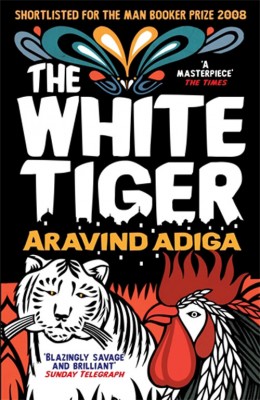The story of a poor man’s life is written on his body, in a sharp pen

The White Tiger
by Aravind Adiga
This book looked like a fun read that would be something a bit different, and that’s pretty much exactly what it was. I enjoyed it greatly but in the week since I finished it, it hasn’t really stayed with me.
The style is initially surprising and unusual. The story is written in the form of letters addressed to Chinese premier Wen Jiabao from Balram Halwai, a self-proclaimed entrepreneur from a very poor background. Balram wants to tell his life story, beginning with how he got the nickname White Tiger and up to how he is wanted by the police. Through this device, Adiga exposes the state of India, or his opinion of the state of India, at any rate. And it’s not a particularly favourable opinion.
“It is an ancient and venerated custom of people in my country to start a story by praying to a Higher Power. I guess, Your Excellency, that I too should start off by kissing some god’s arse. Which god’s arse, though? There are so many choices. See, the Muslims have one god. The Christians have three gods. And we Hindus have 36,000,000 gods…Bear with me, Mr Jiabao. This could take a while. How quickly do you think you could kiss 36,000,004 arses?”
This was my pick for book club and from our discussion it looks like I thought there was more to it than the others did. There was a general feeling that the characters were a bit thin, and the overall tale a bit preachy and lacking in shades of grey (though I should note everyone found it funny and enjoyable). I must say I didn’t find it preachy but I’ll allow that it definitely had a message about class and poverty in India. And it’s certainly not subtle either – the humour is savage and the reality that is revealed is shocking.
Balram has a theory that the poor in India are in a chicken coop. Most of them accept this and stay within the bounds of the coop, but those who do try to escape are quickly shoved back in their place. It takes something extraordinary for anyone to escape the coop. He of course is one of the extraordinary (the only escapee we meet in this tale) but he freely accepts that the method he employed to escape is extreme.
“A rich man’s body is like a premium cotton pillow, white and soft and blank. Ours are different. My father’s spine was a knotted rope…cuts and nicks and scars, like little whip marks in his flesh, ran down his chest and waist, reaching down below his hipbones into his buttocks. The story of a poor man’s life is written on his body, in a sharp pen.”
Balram is a genuinely funny narrator. Since being told that he is as rare as a white tiger when he was the smartest kid in school, he has had ideas above his station. He’s also selfish, objecting to his grandmother’s repeated requests that he share his earnings with his family. He talks through his life, from working in a tea shop in a small village, to being a rich man’s driver in Delhi, to being a businessman in Bangalore. He reveals early on that he has done something shocking, so that most of the book is the answer to the question why and how.
“In the belief that the future of the world lies with the yellow man and the brown man now that our erstwhile master, the white-skinned man, has wasted himself through buggery, mobile phone usage and drug abuse, I offer to tell you, free of charge, the truth about Bangalore.”
This is not a book for those who want a subtle exploration of how modern India operates, or if you want a wide-reaching study of Indian society. It is a funny, easy-to-read, fast-paced window opened just a crack onto a version of reality. I genuinely enjoyed it and even learned a few things but I can’t say that it changed my view of the world or stunned me with its language. Not every book can do that.
Published 2008 by Atlantic Books.
Winner of the 2008 Booker Prize.
Source: A book swap.
Challenges: This counts towards the 2013 TBR Pile Challenge
I enjoyed reading this, especially because of the directness of the narrators voice. But like you felt it didn’t really stay with me that much. He did paint a pretty accurate view of modern day India though where gleaming glass shopping malls have sprung up right next to shanty communities who don’t have even running water.
Karen Yes, an Indian friend told me that when the book came out it was reviewed well in India because it’s an accurate portrait, albeit an unflattering one.
I’d like to read this novel or author in the future. Sounds like an interesting / different style